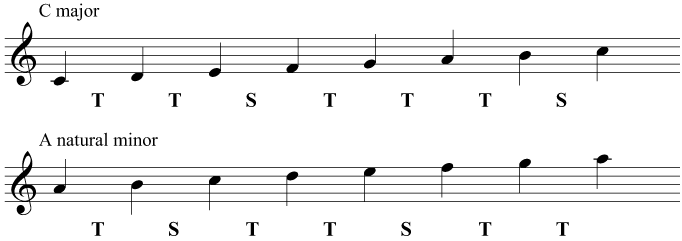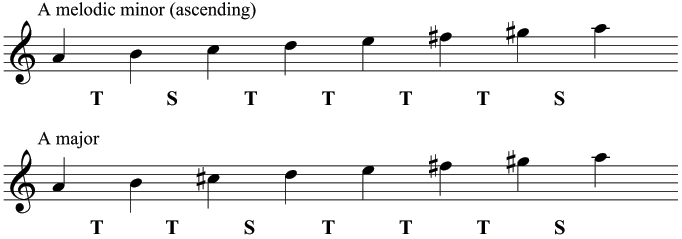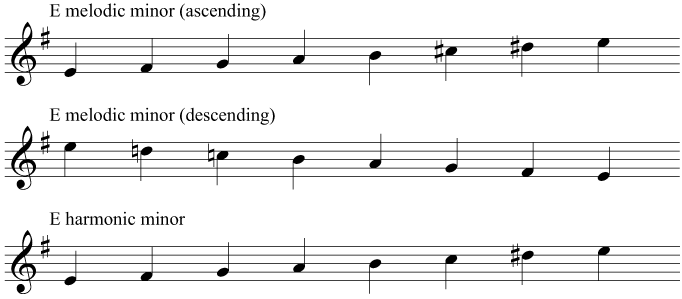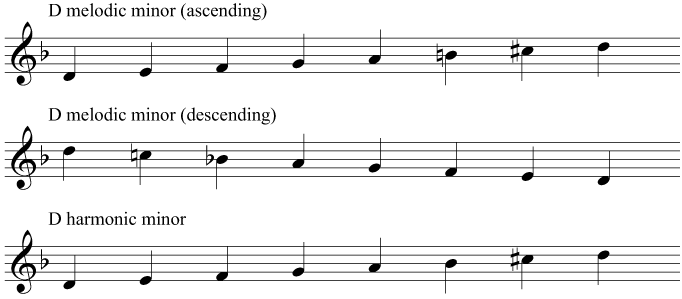The minor scale
In this guide...
Key terms:
Subscription required!
To view the complete study guide, you will need a valid subscription. Why not subscribe now?
Already have a subscription? Make sure you login first!
Introduction
We have looked already at how to construct major scales and key signatures. In this guide we will learn how to do the same for minor scales and key signatures.
The major scale: a reminder
As a quick reminder, let's look again at how we formed the scale of G major from the same pattern of tones and semitones that formed the scale of C major:
 Forming a C major scale from semitones and tones
Forming a C major scale from semitones and tonesThis gives us the characteristic pattern of tones and semitones for a major scale:
T-T-S-T-T-T-S
Recall also how we derived the key signature of G major by moving the F sharp accidental to the beginning of the stave:
 Deriving a G major key signature
Deriving a G major key signatureThe minor scale
If we're using only natural notes, we don't have to always start on C. If we start on A, keeping only natural notes, we end up with the sequence: A, B, C, D, E, F, G.
This is a natural minor scale: notice how the pattern of tones and semitones is different to the pattern in C major:
 Comparison of C major and A natural minor
Comparison of C major and A natural minorThe characteristic pattern
The characteristic pattern of the natural minor, therefore, is:
T-S-T-T-S-T-T
Compare this with the major scale pattern, and spot the differences!
Major scale: T-T-S-T-T-T-S
Natural minor scale: T-S-T-T-S-T-T
It's unfortunately not quite as simple as that, however - minor scales come in a few variations, as you have probably discovered while learning scales on your instrument!
A minor: melodic
The natural A minor scale shown above is also the descending melodic minor scale of A minor. The melodic minor is a specialised version of the natural minor, and as its name suggests, it is most often used for melodic writing in the minor key.
When playing a melodic minor scale, recall that it is different on the way up compared to the way down - the ascending version begins like the natural minor scale (T-S-T-T) but ends the same as the major key starting on the same note (T-T-S):
 Comparison of A melodic minor (ascending) and A major
Comparison of A melodic minor (ascending) and A majorHere is the complete A minor melodic scale, then, ascending and descending. The descending version is exactly the same as the natural minor.
 A melodic minor, ascending and descending
A melodic minor, ascending and descendingA minor: harmonic
There is yet another form of the minor scale: the harmonic minor. Again, as its name suggests, this is often used in minor keys for the creation of harmony (meaning notes sounding at the same time, such as in chords and accompaniment).
This scale is the same "up" and "down", and has one accidental, as shown here:
 A harmonic minor
A harmonic minorMinor keys
Minor scales are associated with minor keys in the same way that major scales are associated with major keys, and their key signatures. We have to be a bit careful, however, in working out the key signature of a minor key.
Let's consider the natural minor scale again, but this time starting on E. This simply copies the same pattern of tones and semitones as found in the natural minor scale on A:
 E natural minor
E natural minorClearly there are the more complicated melodic and harmonic versions of the scale to consider, but the natural minor is the most basic and is the one we use to write down the key signature. Here we can see the formation of the E minor key signature from the natural E minor scale:
 E natural minor
E natural minorPosition of the key signature
Notice that the sharp sign for F sharp appears on the top line, and not in the bottom space. The convention with key signatures is to:
- Put the sharp (or flat) in the highest available line or space, without going out of the stave
This rule is the same for all other key signatures, in all clefs, so it's worth remembering!
Be careful!
Here are the melodic and harmonic scales of E minor, written using the key signature of E minor that we created above:
 E melodic and harmonic minor scales
E melodic and harmonic minor scalesNow, be careful! Do not be tempted to think that you can move those extra accidentals into the key signature - you can't!
One good reason for this is that, for example, the C sharp in the ascending E melodic minor scale is not there in the harmonic minor, so if it was there in the key signature, you would have to constantly write in natural signs in your harmony every time you used a C.
Similarly, not all the D's in these scales are D sharp - there is a D natural in the ascending melodic and in the natural minor.
The convenience of key signatures is that we don't have to write in constant accidentals, so in the case of minor keys, we only use the flats and sharps that are common to all the minor scales in that key.
Therefore, in the case of E minor, we only use F sharp in the key signature!
D minor
Just as with major scales and key signatures, we can use the same technique to write down key signatures using flats. Here are the minor scales and key signatures in D minor:
 D melodic and harmonic minor scales
D melodic and harmonic minor scalesRelative keys
So far, we have seen several major and minor keys, with differing sharps and flats in the key signature. Let's recap:
- No flats or sharps: C major and A minor
- One sharp: G major and E minor
- One flat: F major and D minor
- Two sharps: D major
You will soon come across the scale and key of B minor, which also has two sharps just like D major.
Notice that each of these pairs of scales has the same key signature; a key with one flat will always have B flat as that one flat (F major and D minor, in other words). There are no other keys that have one different flat - for example there are no keys that just have an E flat in the key signature!
These pairs of keys are said to be relative keys: A minor is the relative minor of C major, and F major is the relative major of D minor.
A minor third
Just as A minor and C major have the same key signature, so do G major and E minor, and F major and D minor.
What is the interval between A and C? How about between G and E? And F and D? All are a minor 3rd - a pattern that you will see for every major and minor key pair!
Many keys
You will eventually learn major and minor scales starting on any of the 12 notes, and each major scale will have a relative minor (and vice-versa, every minor scale will have a relative major).
Using the pattern of tones and semitones described here for C major and A minor, you can already create any of these scales.
And using the principle of moving accidentals in the major and natural minor scales to the start of the stave, you can already create any key signature for any key!
We will cover many of these keys and scales in following study guides, but the techniques used here are the same for all of them.
Read more...
With a subscription to Clements Theory you'll be able to read this and dozens of other study guides, along with thousands of practice questions and more! Why not subscribe now?
Revision
Are you sure you've understood everything in this study guide? Why not try the following practice questions, just to be sure!